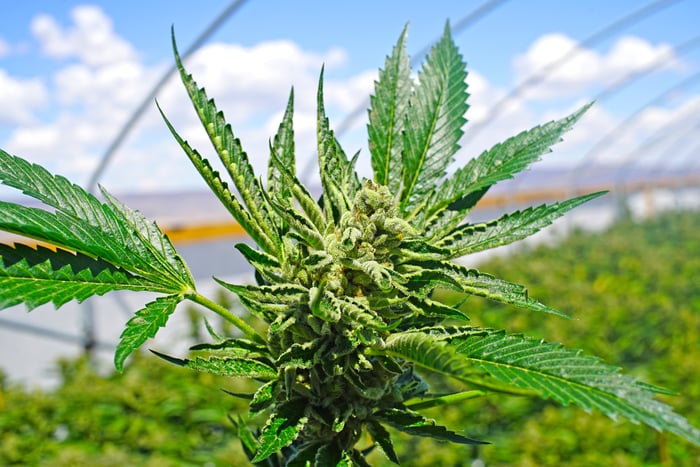Although earnings season never really ends, it's about to ramp up in a big way for the cannabis industry. Among the dozens of pot stocks slated to report in the weeks to come, perhaps none has the attention of Wall Street more than Aurora Cannabis (ACB 12.87%).
The fact that all eyes are on Aurora should surprise absolutely no one. Aurora Cannabis is the most-held stock on online investing app Robinhood, and the company is projected to be Canada's production leader. Already producing at an annual run rate of 150,000 kilos as of the end of March, Aurora has guided investors to expect annual run-rate output of at least 625,000 kilos by the end of fiscal 2020 (June 30, 2020). When all 15 of its grow farms are fully operational, in excess of 700,000 kilos a year of cannabis production is very feasible.

Image source: Getty Images.
Aurora Cannabis provides fiscal fourth-quarter guidance
What's of particular interest with a company the size of Aurora is how economies of scale could come into play. As larger grow farms come on line, the expectation is that the price per gram to produce marijuana should decline substantially, leading to a healthy uptick in margins. Aurora's fiscal fourth-quarter report, detailing its result between April 1 and June 30, should begin to highlight these advantages.
Even though Aurora isn't slated to report its quarterly results for weeks, the company did excite Wall Street by providing sales guidance for its fiscal fourth quarter on Tuesday, Aug. 6. According to a preliminary review, the company expects to report (Aurora reports in Canadian dollars) between CA$100 million and CA$107 million in net fourth-quarter sales, excluding excise tax paid, with year-end revenue of between CA$249 million and CA$256 million. Furthermore, production available for sale in the fourth quarter is expected to range between 25,000 and 30,000 kilos, which is above its previous forecast of 25,000 kilos, leading to CA$90 million to CA$95 million in net cannabis revenue.
Additionally, the company expects to report sequential quarterly improvements in a number of key performance indicators, such as gross margin and cash costs per gram produced. Aurora also notes that it "continues to track toward positive adjusted EBITDA, and in particular adjusted EBITDA from cannabis operations."
However, this update doesn't tell the full story. Here are the three things you should know about Aurora's fiscal fourth-quarter guidance.

Image source: Getty Images.
1. Sequential sales growth is really picking up, meaning supply issues are abating
Arguably, the biggest takeaway from Aurora's fiscal fourth-quarter update is that its production and sales are really beginning to pick up. After the company reported CA$65.1 million in net revenue in the third quarter, the midpoint of Aurora's Q4 update suggests sequential sales growth of about 59%. That's pretty impressive.
More importantly, though, it speaks volumes about the supply issues that the industry has been contending with in Canada.
As you may be aware, Health Canada was contending with a backlog of more than 800 licensing applications at the beginning of the year. This backlog, and the regulatory agency's arduous review process, often resulted in wait times for cultivation, processing, and sales licenses of months, or more than a year. This worked to keep cannabis off dispensary store shelves. However, recent changes implemented by Health Canada, coupled with a possible easing of compliant packaging shortages, appear to be making headway on persistent supply issues throughout the country. There's still a long way to go to resolve Canada's supply problems, but things look to be heading in the right direction, at least based on Aurora's rapid sequential sales growth.

Image source: Getty Images
2. This looks to be a revenue beat, but forecasts are all over the place
On the surface, Aurora's sales guidance looks to have topped most Wall Street forecasts, although that's not saying a lot given how analysts have been all over the place with their projections.
Of the 10 analysts currently offering sales projections for Aurora's fiscal Q4, the average estimate calls for CA$112.8 million in revenue, with a high of CA$132.4 million and a low of CA$88.8 million. However, Wall Street's projections are almost always for gross revenue, not net revenue, which factors in excise taxes paid. Based on what Aurora paid in excise tax in the sequential third quarter, a midpoint of CA$103.5 million in Q4 net sales suggests that gross revenue will come in around CA$120 million. That would be about CA$7 million higher than Wall Street's consensus.
But, as noted, the maturation of the cannabis industry is as much a learning curve for Wall Street as it is for John and Jane Q. Investor and the pot companies themselves. That means sale projections from analysts should probably be taken with a grain of salt for the foreseeable future.

Image source: Getty Images.
3. Profitability is far from a guarantee
Lastly, it's important to realize that even though Aurora Cannabis remains on track to potentially achieve positive adjusted EBITDA during the fourth quarter, this is not the same thing as saying that the company is profitable. Chances remain very good that, on an operating basis, Aurora Cannabis will still lose money in the fiscal fourth quarter and for the full year in 2020.
Based on the company's update, it's pretty clear that Aurora's margins are set to improve. But keep in mind that the company is still seeing plenty of capital fly out the door as it develops its largest production facility, Aurora Sun, and lays the infrastructure needed to be successful domestically and abroad. Not to mention that Aurora's penchant for acquisitions tends to add to near-term costs. All of these factors suggest that recurring profitability is still a ways out for the company.
Further complicating matters is the CA$3.18 billion that it was carrying in goodwill at the end of March. It's beginning to look as if the company grossly overpaid for a number of its puzzle pieces, which makes it increasingly likely that Aurora will write down the value of some of these acquisitions sooner rather than later. The magnitude of these possible writedowns ensures that Aurora could lose money for some time to come.





